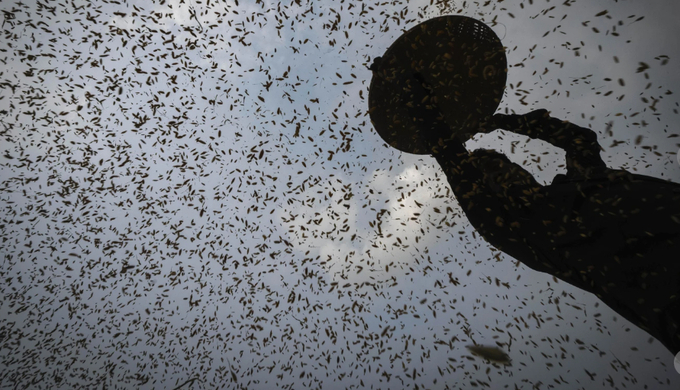November 25, 2025 | 15:07 GMT +7
November 25, 2025 | 15:07 GMT +7
Hotline: 0913.378.918
November 25, 2025 | 15:07 GMT +7
Hotline: 0913.378.918

A farmer harvests rice crop in a paddy field on the ouskirts of Guwahati, India June, 6, 2023.
The FAO Food Price Index, which tracks monthly changes in the international prices of commonly traded food commodities, was 13.7% lower last year than the 2022 average, but its measures of sugar and rice prices growing in that time.
Last month, the index dropped some 10% compared with December 2022. The drop in food commodity prices in 2023 comes despite a difficult year for food security around the world.
Climate effects like dry weather, flooding and the naturally occurring El Nino phenomenon, combined with fallout from conflicts like the war in Ukraine, bans on food trade that have added to food inflation and weaker currencies have hurt developing nations especially.
While food commodities like grain have fallen from painful surges in 2022, the relief often hasn’t made it to the real world of shopkeepers, street vendors and families trying to make ends meet.
More than 333 million people faced acute levels of food insecurity in 2023, according to another U.N. agency, the World Food Program.
Rice and sugar in particular were problematic last year because of climate effects in growing regions of Asia, and prices have risen in response, especially in African nations.
With the exception of rice, the FAO’s grain index last year was 15.4% below the 2022 average, ”reflecting well supplied global markets.” That’s despite Russia pulling out of a wartime deal that allowed grain to flow from Ukraine to countries in Africa, the Middle East and Asia.
Countries buying wheat have found supply elsewhere, notably from Russia, with prices lower than they were before the war began, analysts say.
The FAO’s rice index was up 21% last year because of India’s export restrictions on some types of rice and concerns about the impact of El Niño on rice production. That has meant higher prices for low-income families, including places like Senegal and Kenya.
Similarly, the agency’s sugar index last year hit its highest level since 2011, expanding 26.7% from 2022 because of concerns about low supplies. That followed unusually dry weather damaging harvests in India and Thailand, the world’s second- and third-largest exporters.
The sugar index improved in the last month of 2023, however, hitting a nine-month low because of strong supply from Brazil, the biggest sugar exporter, and India lowering its use for ethanol production.
Meanwhile, meat, dairy and vegetable oil prices dropped from 2022, with vegetable oil — a major export from the Black Sea region that saw big spikes after Russia invaded Ukraine — hitting a three-year low as global supplies improved, FAO said.
(AP)
/2025/11/24/3616-2-141832_513.jpg)
(VAN) FSC certification has helped increase the value of thousands of hectares of planted forest timber under the management of the Xuan Loc Protection Forest Management Board, particularly in terms of selling prices.

(VAN) More than 100 shoppers queued for a chance to get a kilo or so of Japanese rice for 500 yen ($3.32) by heaping as much grain into a small wooden box as possible.

(VAN) Benchmark international prices of milled declined in October as harvests started or improved in some parts of the globe.

(VAN) Show cause orders will be issued to retailers who sell imported rice at prices exceeding the maximum suggested retail price (MSRP) of P43 per kilo, Philippines Agriculture Secretary said in a statement on Thursday.

(VAN) Coffee prices on October 20, 2025, remained stable domestically, trading at 113,500–114,500 VND/kg. Similarly, global coffee prices also moved sideways.

(VAN) By October, Vietnam’s coffee exports had surpassed USD 7 billion for the first time and will exceed USD 8 billion within this year.

(VAN) Illinois rancher says Texas, Oklahoma, Kansas lost grass and forage, forcing massive cattle liquidation.